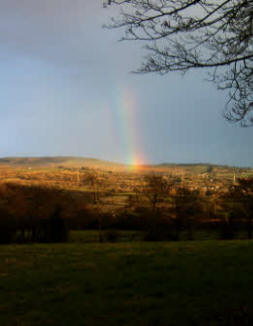
Reading the signs
THE DIGGER

The weather gall or gaw appears over the Stoneyford area on the afternoon of Thursday 28th February 2008.
Earlier this year, as I bade goodbye to an old friend at his front door, I caught him looking over my shoulder, eyes fixed on the horizon.
“There’s stormy weather ahead,” he remarked.
“How exactly to you work that one out?” I asked.
I certainly hadn’t heard the fire murmuring in his sitting room where we had spent the afternoon yarning. That was a common indicator of a storm to the older generation in the district. I had turned round half expecting to see the local cattle lying in the field or the crows gathering above the trees. I could see neither.
“Sure there’s the weather gall over there,” he replied, his right hand pointing towards the sky.
The terminology temporarily confused me, as it probably would do with the younger generation. A little bit more prompting from my old friend pointed me in the direction of a rainbow. On this occasion it appeared as a half rainbow. He assured that good luck wouldn’t be associated with this weather gall, and there was certainly no crock of gold deposited at the foot of it.
I checked the terminology with some of the older residents in the district who corroborated my friend’s tale. In fact some referred to the phenomena as a “weather - gaw.” Suspecting an Ulster-Scots link I checked my eighty-year old faithful Scots dialect dictionary. There it was -“weather-gaw - the lower part of a rainbow left visible above the horizon; a gleam of sunshine between storms…”
In fact, Shakespeare made a brief reference to a similar word in his work titled “The Rape of Lucrece.”
“ And round about her tear-stained eye
Blue circles streamed; like rainbows in the sky;
These water-galls in her dim element
Foretell new storms to those already spent….”
I did forget to remind my old friend that it was considered unlucky to point at a rainbow. I’m sure that includes any portion of the coloured arc!
One of those sounds from one’s childhood cemented into the memory may well include the knocking of a parent’s knuckle against the glass of the wall-mounted “banjo”. For me it remained a mystery object, until such times as a science teacher would explain the principles of the aneroid barometer.
In former days the barometer would have been a luxury in rural districts. Instinct and country ways were relied on for weather prediction.
When Felix or Jimmy had finished his tea after a hard day’s work and had decided to take a walk over to the neighbouring farm he may well have taken on board the wet weather indicators before venturing out. As he reached for his clay pipe from the pipe-stand to the right of the crook, he may well have noticed the crickets livening up on the hearth, and scowled to himself as his joints start to ‘stoon’ and ache. The smoke from the pipe would keep the gathering flies at bay in the house. As he turned the jamb-wall, he would surely notice the abandoned spider’s web in the top corner. The sticking half-door as he looked over towards the falling clouds on the nearby hills would be the ultimate reminders to take his coat from the peg behind the door before stepping onto the yard. It would not be long before the residents of the neighbouring farm sensed the arrival of their visitor. It would not be the stray coal onto the hearth that would alert them to the visitor, but the distinct smell of the tobacco in the pipe emissions as Felix or Johnny made their way up their loanin. It was common knowledge in those times that when the pipe smell was stronger it would surely rain.
In the early 1920’s the BBC commenced broadcasting weather forecasts. If father had decided to stay in that evening, you may have been warned to tone down the noise as he donned the bakelite headphones to listen to the daily weather broadcasts via the family crystal radio set. I have been told it was best to be out of father’s way as he “futtered with the cat’s whisker” on the drop-leaf.
But that’s another story!!
The Digger can be contacted by email - diggerarticle@hotmail.com
14/03/2012
